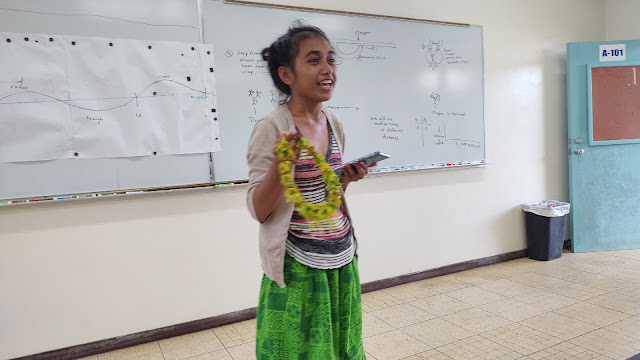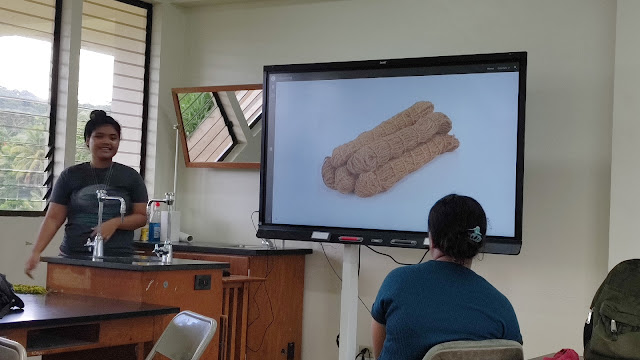Material culture
Joana Amyda shared a carved wooden turtle carved by Kapingan carvers called a digee.
Coconut fiber rope. I opted to permit students to pre-submit images for large objects that could not be brought to class, but his opened the door to images of smaller or other objects. This has me rethinking this whole presentation. Students in the past would bring a coconut basket or other item they had made. This term the students were more hard pressed than ever to bring something that is actually in active use in their daily life. I could have been more clear about this, but that might not have helped. There is so much loss of material culture.
At one time a student might have at least put the koahl on over their western clothes. In this case Jessa does not have a koahl that will fit her, so she has brought one for a small child typical of those used by early childhood education students at their ECE day cultural fair. Again, this is not a daily use item but more accurately a once in a lifetime wear, maybe like a wedding dress in some sense.
In the past students would have brought in a broom. Again, devolution in the presentations.
Drewnida Mack brought a local purse made by Kapingan women
On the edge of the lid and the upper edge of the purse the light white material is coconut frond. The bulk of the purse is made from pandanus leaves. Pandanus provides both the light and the dark material.
Ashli Gwen Manuel brought a pwaht
The class seemed to be unaware of the source word for pwaht, plate. A pwaht was a modern response to individual serving plates used by foreigners. Food as belonging to one person, rather than a shared commodity. A kiam contains "our" food, a pwaht can contain only "my" food. This too is a change in thinking. Before there was only "our" food, now there is "my" food. The shift from the us to a me, to individuality. This is not to judge either way - whether the shift to the "capital I" is good or not good, just that this is a change in self-perception and how objects are owned or not.
Reenomilyn Mori
This was another presentation where I was on new terrain. Yes, this is used in Chuuk. But this is essentially a museum piece in a glass case at the library. This is not where I want the material culture presentations to go, but it seems that they will surely all go here: to pictures on a SMARTboard. I am thinking that the presentation may have to be optional and that a student must bring something from their own home that is material culture, traditional, still in use, and made from a plant. Hence this would be optional. I cannot see another way forward with this presentation.
The attempt was to present coconut fiber rope, but lacking any to get a hold of, the presentation was of jute from the hardware store. Yet again, a strong demonstration of the lack of available material culture in the homes here. And a misunderstanding of the nature and intent of the presentation.
Daman Perman
This is actual coconut fiber rope, hand made, and now apparently quite rare.
A.J. Pelep
In Wapa, Madolehnihmw this weipwul pole (Morinda citrifolia) is used to break the Sakau en Enilahp (Sakau Ro). There the pole is called a lakaukodelang according to AJ, not kirikei. "kirikei n. a stake made from the noni (weipwul) tree, used for splitting a clump of kava roots, typically ten to twelve inches in diameter and six to seven feet long, sharpened flat on one end."
"lakaukod meing. n. a stake made of mangrove, used for splitting a clump of kava roots, typically ten to twelve inches in diameter and six to seven feet long, sharpened flat on one end. cf. kohd₂."
"lang vi. to be hung up. – langa, vt.
langalang vi. to be open, as of a business.
langada vi. to be tied to something overhead; to be opened."
langalang vi. to be open, as of a business.
langada vi. to be tied to something overhead; to be opened."

















Comments
Post a Comment